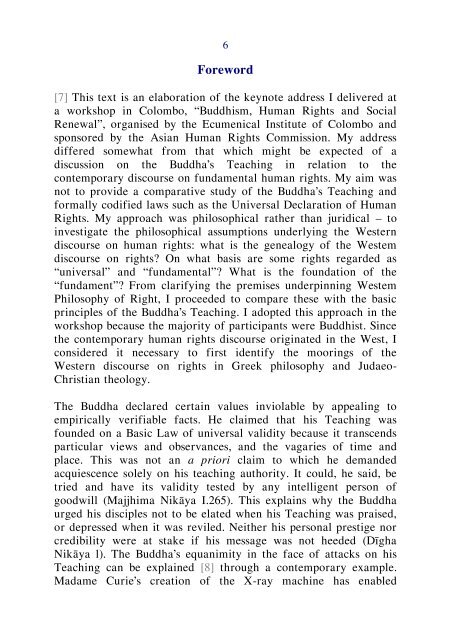Nalin Swaris: Buddhism, Human Rights and Social Renewal
Chapter 1, Foundations of the Western Philosophy of Right Chapter 2, Brahmin Political Theory Chapter 3, The Buddha and His Times Chapter 4, Basic Premises of the Buddha’s Message of Liberation Chapter 5, The Buddha’s Declaration of Human Biological Unity Chapter 6, The Buddha’s Theory of Right Chapter 7, The Buddha’s Theory of Statecraft Chapter 8, The Buddha’s Economic Philosophy Chapter 9, An Alternative Model for Society: the Buddha Sangha Chapter 10, Early Buddhism and Later Centuries Asoka’s Edicts: The First Bill of Human and Animal Rights
Chapter 1, Foundations of the Western Philosophy of Right
Chapter 2, Brahmin Political Theory
Chapter 3, The Buddha and His Times
Chapter 4, Basic Premises of the Buddha’s Message of Liberation
Chapter 5, The Buddha’s Declaration of Human Biological Unity
Chapter 6, The Buddha’s Theory of Right
Chapter 7, The Buddha’s Theory of Statecraft
Chapter 8, The Buddha’s Economic Philosophy
Chapter 9, An Alternative Model for Society: the Buddha Sangha
Chapter 10, Early Buddhism and Later Centuries
Asoka’s Edicts: The First Bill of Human and Animal Rights
You also want an ePaper? Increase the reach of your titles
YUMPU automatically turns print PDFs into web optimized ePapers that Google loves.
6<br />
Foreword<br />
[7] This text is an elaboration of the keynote address I delivered at<br />
a workshop in Colombo, “<strong>Buddhism</strong>, <strong>Human</strong> <strong>Rights</strong> <strong>and</strong> <strong>Social</strong><br />
<strong>Renewal</strong>”, organised by the Ecumenical Institute of Colombo <strong>and</strong><br />
sponsored by the Asian <strong>Human</strong> <strong>Rights</strong> Commission. My address<br />
differed somewhat from that which might be expected of a<br />
discussion on the Buddha’s Teaching in relation to the<br />
contemporary discourse on fundamental human rights. My aim was<br />
not to provide a comparative study of the Buddha’s Teaching <strong>and</strong><br />
formally codified laws such as the Universal Declaration of <strong>Human</strong><br />
<strong>Rights</strong>. My approach was philosophical rather than juridical – to<br />
investigate the philosophical assumptions underlying the Western<br />
discourse on human rights: what is the genealogy of the Westem<br />
discourse on rights? On what basis are some rights regarded as<br />
“universal” <strong>and</strong> “fundamental”? What is the foundation of the<br />
“fundament”? From clarifying the premises underpinning Westem<br />
Philosophy of Right, I proceeded to compare these with the basic<br />
principles of the Buddha’s Teaching. I adopted this approach in the<br />
workshop because the majority of participants were Buddhist. Since<br />
the contemporary human rights discourse originated in the West, I<br />
considered it necessary to first identify the moorings of the<br />
Western discourse on rights in Greek philosophy <strong>and</strong> Judaeo-<br />
Christian theology.<br />
The Buddha declared certain values inviolable by appealing to<br />
empirically verifiable facts. He claimed that his Teaching was<br />
founded on a Basic Law of universal validity because it transcends<br />
particular views <strong>and</strong> observances, <strong>and</strong> the vagaries of time <strong>and</strong><br />
place. This was not an a priori claim to which he dem<strong>and</strong>ed<br />
acquiescence solely on his teaching authority. It could, he said, be<br />
tried <strong>and</strong> have its validity tested by any intelligent person of<br />
goodwill (Majjhima Nikāya I.265). This explains why the Buddha<br />
urged his disciples not to be elated when his Teaching was praised,<br />
or depressed when it was reviled. Neither his personal prestige nor<br />
credibility were at stake if his message was not heeded (Dīgha<br />
Nikāya l). The Buddha’s equanimity in the face of attacks on his<br />
Teaching can be explained [8] through a contemporary example.<br />
Madame Curie’s creation of the X-ray machine has enabled
















